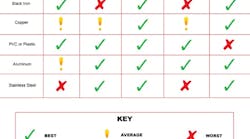By Chad Larrabee
For companies that need to add compressed air piping for an expansion or new production equipment, designing the piping structure is critical to overall system efficiency and reliability. While most designers look at variable-speed drive (VSD) compressors or controls to enhance system efficiency, piping remains an important contributor to system optimization. Piping makeovers can contribute greatly to total system efficiency.
There are four things to consider in examining how piping affects system efficiency:
- Pipe diameter – Pipes that are too small cause a high pressure drop. If systems lose pressure, businesses lose money because they need to produce more air to overcome the pressure differential.
- Lack of loop design in primary header – This causes overpressurization on the supply side to counteract pressure loss.
- Connections – Poor connections can cause leaks. If operations lose air flow, they lose money. When air escapes the compressed air system, more air needs to be generated to compensate for the loss of power.
- Materials of construction – Some piping materials are more susceptible than others to corrosion and higher pressure loss.
Size matters
Piping systems tend to be designed for the anticipated flow at the time of original construction. It could be that a system has grown without the header system growing with it, or operations may have a problem with pipe size or fittings in the compressor room. Piping also often is sized for the connection size of the component, such as the filter inlet and outlet size, or the compressor discharge size. This strategy does not take into account the important criteria of flow, pressure, or distance required for the transmission. For example, consider a 2-inch diameter pipe connected to the outlet of a 2-inch threaded connection filter sized for 1,000 cubic feet per minute (cfm). If this filter cleans 1,000 cfm of air at 100 pounds per square inch (psig), the undersized piping would lose more than 5 psi over just 100 feet of pipe, which can cost roughly $3,000 per year in power to overcome the pressure differential.
Increasing pipe size helps reduce pressure drop and also adds to the system's capacitance. Although increased capacitance helps with system efficiency, there is a commercial consideration to make, too. If businesses are designing piping for flow rates of 1 psig or less per 100 feet of pipe, that is a commercially viable piping size, but other factors may go into the diameter selection decision-making.
Chad Larrabee is director of services marketing in North America for the air business of Ingersoll Rand. He is responsible for all parts and service offerings, including the advanced services of system assessments for optimization and removing waste in compressed air systems. Larrabee has 23 years in the compressed air industry and currently serves as education committee chairman for the Compressed Air and Gas Institute.
Loop de loop
If a compressed-air distribution design is a single trunk with branches versus a distribution ring with branches, plants may want to think about how to run a parallel pipe from the end of the trunk back to the point of generation and then connect them on each end, creating a loop design in the header. This design ensures the same pressure at any point in the loop. A straight-run trunk design with branches can rob the last user of air and create a situation in which the entire system pressure is inefficiently elevated to overcome the pressure loss at the end of the line. This is a fundamental detail but is often overlooked. Other issues, too, may cause the last user lack of air: Consider a large air event occurring in the system. It's a good idea to measure first to determine whether the user will receive the pressure needed for the application.
Conjunction junction
Another weak link in a compressed air design can be the where pipes come together. Whether a joint, a filter, a regulator or a valve, a compressed air connection is a possible leak source. Using the appropriate seal and quality components will minimize the likelihood of losses resulting from leaks. Regular leak studies are a best practice and help form a good maintenance and system efficiency strategy.
Pipe type hype
Multiple options exist for pipe material: black iron, copper, PVC or plastic, aluminum, and stainless steel. While there is nothing exciting about black iron pipe, it is commonly used for compressed air despite availability of better alternatives. Black iron hosts the compressed air in a moisture- and oxygen-rich environment, accelerating corrosion and ultimately creating a nasty combination of scale and/or sludge moving through the piping system – this is harmful to valuable and sensitive production equipment. Laminar flow is interrupted and pressure drop is created with the turbulence. Some operations go with copper or even a composite such as PVC as an alternative. There are inherent safety risks associated with PVC when applying it to compressed air; the piping can become brittle and shatter.
Aluminum is noncorrosive and has reasonable acquisition costs. Many suppliers sell aluminum pipe that is designed specifically for compressed air applications. Diameters up to 10 inches are available. Aluminum pipe has smooth bore for low resistance and low pressure drop and is corrosion-resistant. It also is light and easy to work with and has simple connections for faster installation. Often, aluminum has a higher initial investment but lower installation costs as compared with other materials.
Finally, the solution with the best qualities for efficiency and corrosion resistance is stainless steel, but it is often cost-prohibitive both in material cost and in the cost of installation.
Consult your compressed air system professional for more information on how you can help ensure that your piping design optimizes your air system instead of squeezing your profits.
